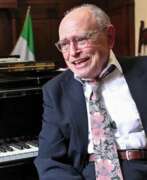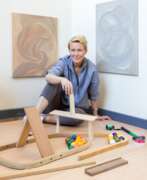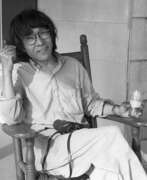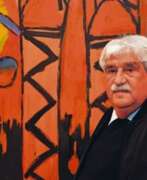Scenographers 21st century


Christian Ludwig Attersee, born Christian Ludwig, is an Austrian media artist living in Vienna and Semmering in Lower Austria.
The artist took his middle name, Attersee, from the area where he spent his youth. He studied at the Vienna Academy of Applied Arts and his work was characterized early on by flamboyant sexualization. He is known not only as a visual artist, but also as a musician, writer, object artist, designer, stage designer and film director. In the 1960s and 1970s he also created series on themes of food, everyday objects, beauty and cosmetics.
Attersee is known above all as one of the leading representatives of objective painting in Europe in the last 50 years. In the second half of the seventies he became the founder of the "New Austrian Painting". From 1990 to 2009, Atterse held a chair at the Vienna University of Applied Arts.


Margit Balla is a Hungarian artist, graphic artist, illustrator, director, stage designer and costume designer.
She studied typography at the Academy of Applied Arts in Budapest, mainly making posters, book illustrations, later working more and more with pictorial graphics. In her posters Margit Balla combines impressions from old prints with contemporary trends such as pop art. Her figurative compositions are easily recognizable by her special surrealistic drawing style.
Since 2000, Margit Balla has been working as a production designer for the Budapest Puppet Theater.


Tilo Baumgärtel is a German artist who lives and works in Leipzig.
His paintings go back to the works of social realism and large-format propaganda posters. The artist works with a variety of mediums and techniques. In addition to painting, he also uses lithography, drawings on paper, and video. Pictorial space and the creation of sometimes surrealistic landscapes is one of his central themes.
Tilo Baumgärtel also collaborates with theaters, developing sets and videos on scenography.


Silvano Bussotti is an Italian composer, painter and opera director, set and costume designer.
Silvano learned to play the violin at an early age, studied harmony and counterpoint at the Cherubini Conservatory in Florence, and studied with various teachers. In addition to music, he was fond of drawing and painting. His first works, influenced by Luigi Dallapiccola and Roberto Lupi, were written in the avant-garde dodecaphonic technique, and he also made extensive use of the aleatoric method. Bussotti was a participant in "anti-music" concerts, for which he created works without any sounds at all.
Bussotti's compositions include numerous pieces for various vocal, instrumental and mixed ensembles. In 1963 he co-founded the Group of 70 (Florence). Between 1968 and 2001 he worked as a director, costume designer and stage designer at the leading opera houses in Italy, La Scala, La Fenice; Massimo (Palermo), Reggio (Turin) and others. In total, he created about 40 opera productions.
Bussotti's art exhibitions are held in various countries around the world. Bussotti is also known for his extravagant graphic scores, in which he found self-expression as an artist, but this hides the meaningful nature of his musical achievements.


Ilya Sergeyevich Glazunov (Russian: Илья́ Серге́евич Глазуно́в) was a distinguished Soviet and Russian artist, born on June 10, 1930, in Leningrad, and passing away on July 9, 2017, in Moscow. Glazunov was not just a painter; he was a visionary and an educator who founded the Russian Academy of Painting, Sculpture, and Architecture in Moscow, where he also served as rector until his death. Glazunov's artistry was deeply rooted in historical and religious themes, as seen in masterpieces like Russia the Eternal, The 20th Century Mystery, and The Ruining of the Temple on Easter Night, along with his celebrated illustrations for Fyodor Dostoyevsky's works.
Glazunov's contribution to Russian art and culture was immense. He was a full cavalier of the Order "For Merit to the Fatherland," among other honors, acknowledging his significant role in the national art scene and education. Notably, during the 1970s, Glazunov played a key role in saving parts of Moscow's historic center from destruction due to proposed restoration plans, showcasing his commitment not only to the arts but also to preserving Russia's cultural heritage.
Collectors and experts in art and antiques admire Glazunov for his unique blend of artistic brilliance and dedication to cultural preservation. His works, which are held in high esteem across the globe, are a testament to his skill, vision, and unwavering love for his homeland. For those intrigued by Glazunov's legacy and wishing to explore his works further, subscribing for updates on new sales and auction events related to Ilya Sergeyevich Glazunov is highly recommended. This subscription is an invaluable resource for staying informed about opportunities to own a piece of Russian art history.


Jörg Immendorff was a German painter and sculptor, stage designer and decorator, and a member of the New Wild movement.
Immendorff painted in cycles that often lasted for years and were political in nature. His series of sixteen large paintings, Café Deutschland (1977-1984), is well known. In these colorful paintings, numerous disco lovers symbolize the conflict between East and West Germany.
Immendorff prepared several stage productions and designed sets for the operas Elektra and The Rider's Voyage. 25 of Immendorf's paintings were selected in 2006 for the illustrated Bible.


Muriel Köhler-Docmac, née Tamschick, alias Muche, is a German artist, designer and scenographer living and working in Stuttgart.
She studied at the Academy of Fine Arts in Munich and at the University of Design Karlsruhe, specializing in scenography, then at the Eberhardt-Ludwig Gymnasium in Stuttgart. Muriel Köhler-Dokcmac's background includes the design of commercial spaces and work in stage design, styling, artwork for various music videos and commercials at home and abroad. She also created the interior design of the Munich Theater Academy.
The artist works in a variety of techniques: she paints, spray paints, creates collages and glues materials onto surfaces. She uses perforated sheets, self-cut stencils or even a shower mat to apply her meshes. References to street art, graffiti and comics are also visible in her works, as well as elements of caricature, illustration and pop art. Muche has participated in numerous exhibitions at home and abroad with her paintings.


Jakob Kolding is a Danish and German artist and stage designer.
He graduated from the Royal Danish Academy of Fine Arts and lives and works in Berlin, Germany.
Using sources ranging from historical canons of fine art, literature and theater to pop music, hip-hop, science fiction, urban imagery and contemporary culture, Kolding has created his own visual vocabulary in the collage technique. Building layer upon layer, he brings to life a world as complex as it is aesthetically beautiful. And Kolding's scenography transforms into three-dimensional collages, expanding throughout the space in which they inhabit, creating an entire world.


Sergey Yakovlevich Lagutin (Russian: Сергей Яковлевич Лагутин) was a Soviet and Russian artist of the second half of the twentieth and early twenty-first centuries. He is known as a painter, scenographer, teacher and art theorist.
Sergey Lagutin began his career in 1934 while serving in the army, where he first participated in an exhibition of military artists. Throughout his career, the artist designed theatrical performances and worked in theaters in East Germany and the USSR. His contributions to the field of art include the development of the program and methodology for teaching composition adopted in all art schools in Russia.


Andras Markos is a Romanian, Hungarian and German abstractionist, graphic designer and performance artist.
Andras studied fine arts at the Romanian Academy of Fine Arts, then worked for many years as a graphic designer, became a curator of medieval church art and a production designer for the Hungarian State Theater.
In 1980, Markos emigrated to Germany, also working in Vienna. By 1981, Andras' exhibitions had traveled throughout Europe and America, and he had established himself as an internationally renowned artist. He also founded several art galleries.
Markos' work is based on abstract expressionism and conceptual art. He often worked on thematic series and incorporated words and calligraphic ideas as well as collages into his images. Marcos worked in many techniques including painting on canvas and paper, lithography, silkscreen, etching and ceramics.


Togrul Farman oglu Narimanbekov (Russian: Тогрул Фарман оглы Нариманбеков) was a distinguished Azerbaijani painter and vocal artist, celebrated as a People's Artist of the USSR and Azerbaijan. Born in Baku in 1930, Narimanbekov's life was marked by the trials of his family during political repressions, which deeply influenced his artistic expressions. He studied monumental and decorative painting at the Lithuanian Institute of Fine Arts, launching a prolific career that spanned across various Soviet republics and European countries.
Narimanbekov's art is known for its vivid color palette and dynamic compositions, capturing the spirit and cultural essence of Azerbaijani life. His works are held in several prestigious collections globally, including the Museum of Modern Art in Germany and the Tretyakov Gallery in Russia. Notable pieces include "Caravanserail at Samarkand" and "Sunny Day," reflecting his mastery in portraying historical and everyday scenes with a lyrical quality.
For those interested in exploring the profound artistic contributions of Togrul Narimanbekov, and to stay updated on exhibitions and sales of his works, consider subscribing to updates on his legacy. This subscription will keep you informed about new discoveries, auction events, and available artworks related to Narimanbekov.


August Ohm was a German painter, draftsman and stage designer.
After studying under his father, the painter Wilhelm Ohm (1905-1965), he studied at the Werkkunstschule Hamburg (design and costume designer) and at the University of Hamburg, as well as at the Free University of Berlin (art history). The artist constantly refers to historical models of Western painting.
August Ohm is known for a series of antique faces entitled "Paintings of Antiquity", as well as portraits based on paintings by Lucas Cranach. He also created illustrations of the Apocalypse, desert paintings from Afghanistan, urban themes, "Novalis Paintings" and many others. Since the 1970s, August Ohm has also amassed a significant collection on the history of costume. Since 1982, the artist has lived and worked in Hamburg and has a second studio in Florence.


Niki de Saint Phalle was a French-American sculptor, painter, filmmaker, and author of colorful hand-illustrated books. Widely noted as one of the few female monumental sculptors, Saint Phalle was also known for her social commitment and work.


Dorothea Margaret Tanning was an American surrealist painter, printmaker, sculptor, writer and poet.
In 1935 Dorothea came to New York and worked as an advertising artist until she was inspired by the paintings of the famous Surrealists at an exhibition. She began to paint and exhibit and made numerous acquaintances among contemporary artists. In 1946 she married the artist Max Ernst, and this marriage lasted 30 years. They lived in Paris for a long time, and after his death in 1976, she returned to New York.
As an artist, Dorothea Tanning was self-taught, and her style was constantly changing. At first close to surrealism, by the late 1960s her paintings had become almost entirely abstract. Among her artistic accomplishments are paintings, prints, sculpture, stage design, costume and set designs for ballets, and her work has been exhibited at the Guggenheim Museum, the Metropolitan Museum of Art, the Tate Modern, and the Philadelphia Museum of Art.
In the late 1980s, Tanning began writing poetry, and her work has subsequently been published in various publications. Her first collection of poems, A Table of Content, was published in 2004. The multifaceted and versatile artist died in New York City at the age of 101.


Theofiel Agnes van de Kerckhove was a Belgian painter, graphic artist, set designer and scenographer.
He studied painting at the Antwerp Academy, where he also took classes with sculptors Dekkers, Claessens and Dupont, and joined the Rupelgouw artists' association in Boom in 1936. Van de Kerckhove worked as a stage designer at the opera in Lille, and lived for a time in Germany. Here he worked with Albert Servaes, whom he had met while at the academy. In the 1950s, Van de Kerckhove was a curator at the Rocoxhuis and one of the set designers for Belgian television.


Ulla von Brandenburg is a German media artist and scenographer living and working in Paris.
Ulla studied scenography in Germany at the University of Art and Design Karlsruhe and fine arts at the University of Fine Arts Hamburg. Her projects are realized through a combination of black and white film, installation, performance, drawing and painting, mural painting, theater and video.
Theater is central to the artist's work. She often draws on representational forms from the late nineteenth century and early modernism. Ulla von Brandenburg expresses her love of fabrics and draperies in the creation of peculiar curtains with obvious references to classical theater productions, themes of Harlequin and buffoonery.









































